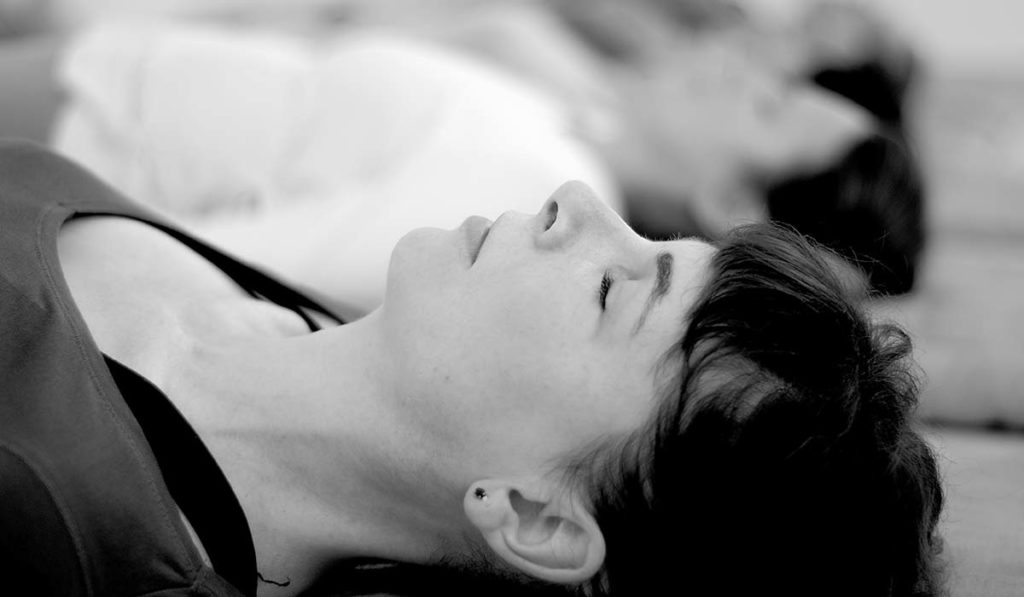Are you practising yoga nidra? Then you might wonder if there is an ideal moment to do this meditative deep-relaxation technique. In this post, I will explore just that. I will look into the ideal time of the day and several other factors that determine when it is best to practice yoga nidra.
Yoga nidra is a meditative deep-relaxation method
Yoga nidra is about entering a state of deep relaxation where you find yourself between sleep and waking. You practice it lying down on your back in savasana (the corpse pose) following the instructions of a guide or a recording. The technique is so efficient that some people find it hard to stay awake. On the other hand, for others, yoga nidra can reveal agitation, making it challenging to get into a deeper state.
The optimal time to practice yoga nidra is when you are most likely to overcome restlessness and simultaneously remain alert and awake. Several factors influence what time that is for you.
Practice yoga nidra at any time of the day as long as you have digested your meals
If you want to practice yoga nidra, the most important thing is that you get around to doing it to begin with. So the most critical factor in deciding when to practice is that your chosen time fits into your life rhythm.
As a basic rule, you can do yoga nidra at any time of the day. But there is one limitation that is imperative to respect: You have to give yourself enough time to digest your last meal fully. That means that you have to wait at least two hours after eating before practising. If you don’t, you run the risk of being overwhelmed by sleepiness.
Find your best time according to your biological rhythm
However, even though you can practice at any time, there are moments during which it is easier to remain conscious in the yoga nidra state. This is because of your biological rhythm.
There are times when you are more alert and times when you are more prone to drowsiness. By paying attention to your biological rhythm, you can thus identify the best time for you. Practising when you feel alert is one of several measures you can take to stay more awake during yoga nidra.

The best time to practice yoga nidra is after asana, pranayama and meditation
It is good to prepare for yoga nidra with yoga poses (asana) and breathing exercises (pranayama), and even meditation. Every practice supports the practice that comes after it. By composing a sequence with several different methods, you can give the practice at the end a tangible boost. So you can build up to yoga nidra by placing it as your final practice. With this dynamic in mind, it is not hard to see that the ideal time for yoga nidra is at the end of a more extended session.
Here are two examples of sequences that build up to yoga nidra.
Example 1
– Alternate breath
– Tratak
– Yoga nidra
Begin with the alternate breath, without any change in sitting pose, continue with the concentration technique tratak. Finally, lie down for yoga nidra.
Example 2
– A sequence of static yoga poses
– Pranayama
– Meditation on Ujjayi pranayama
– Yoga Nidra
You can achieve another excellent buildup by starting with static yoga poses (Swami Janakananda’s classical programme is ideal). Go on with bhastrika pranayama (the blacksmith’s bellows) and nadi shodhana pranayama (the alternate breath). As a final preparatory practice, do a meditation based on Ujjayi pranayama, such as the Source of Energy meditation. Placing yoga nidra after such a robust buildup will make it more profound, more concentrated, with more vivid visualisations.
The best time for doing yoga nidra to improve sleep
A lot of people practice yoga nidra to improve sleep. Yoga nidra and other meditation methods are a proven means of reducing activity in the sympathetic nervous system, making it hard to fall asleep. Yoga nidra will positively impact your night sleep no matter at what time of the day you practice.
Suppose you are a night person that has an alert period late in the evening. In that case, this can be the perfect moment to practice yoga nidra with full awareness. On the other hand, since yoga nidra tends to make stressed people fall asleep, it can also act as a natural sleeping pill if you do it lying in bed. Some people even use yoga nidra to fall asleep again when they wake up in the middle of the night.
Is the early morning the best time for yoga nidra?
Some people argue that the early morning is particularly auspicious for yoga nidra and other meditations. There is no denying that this is a quiet time and that just coming out of night sleep makes you receptive to meditative practices.
The supposedly best time for yoga nidra is Brahmamuhurtha, a time window beginning 03:40 and ending 04:28. In case it is practical for you to practice at this time, then it could give you some advantages. However, you should not overestimate the benefits of early morning meditations. Many other factors influence the quality of your practice.
The time of the day for yoga nidra on Swami Janakananda’s yoga retreats
It might be interesting for you to know what yoga masters think of when to practise yoga nidra. Swami Janakananda is one of the top teachers in the Satyananda tradition, from which yoga nidra originates. He has organised yoga and meditation retreats in Sweden for 50 years. On his yoga retreats, students typically practice yoga nidra around noon just before lunch or as a buildup for a meditation session before lunch.
Key takeaways
- There is no best time to practice yoga nidra. The best time for you depends on several factors.
- You can benefit from yoga nidra any time but it is crucial that you have digested your meal.
- Yoga nidra will improve your sleep no matter what time you practice.
- You can improve yoga nidra by choosing your practice time according to your biological rhythm.
- Practising in the early morning is auspicious for yoga nidra and other meditations but not a guarantee for optimal practice.




